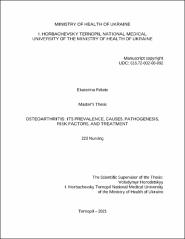OSTEOARTHRITIS: ITS PREVALENCE, CAUSES, PATHOGENESIS, RISK FACTORS, AND TREATMENT
Короткий опис(реферат)
Osteoarthritis is the leading cause of disability in America, affecting persons of all ages, sexes and races. There are two main forms of OA: primary OA and secondary OA.
Primary OA is a chronic degenerative disease related to aging. Although not caused by aging, as a person ages the water content in the cartilage decreases, making the joint less resilient and more at risk of degeneration. There is believed to be a genetic factor involved as well.
Secondary OA begins earlier in life, usually resulting from a specific injury or trauma, repetitive motion injury, or comorbidity of diabetes or obesity. Since the presenting symptoms are the same, i.e., joint pain and stiffness exacerbated by use or exercise, statistically, the two conditions are not generally reported separately.
There are several compelling reasons why researchers are predicting a dramatic increase in the prevalence of osteoarthritis in the coming decades. One is because the condition is associated with advancing age, and, with people in Western countries living longer than ever, the number of elderly people at risk for osteoarthritis is expected to increase. Added to this is the number of young and middle-aged people who are overweight because obesity can be damaging to the joints. A third reason is the large number of people who have suffered injuries, which can also increase their risk of OA.
The CDC currently funds twelve state arthritis programs with the following goals:
(A) to strengthen partnerships with other chronic disease programs, state Arthritis Foundation chapters/regions, and other partners, improve their ability to monitor the burden of arthritis in their state,
(B) to coordinate activities to increase public awareness that something can be done to address the burden and impact of arthritis, and (C) to Expand efforts to promote self-management education and physical activity to adults with arthritis (.
More research is needed to find better diagnostic tools and medicines targeted at reducing or reversing the damage caused by OA, in order to ease suffering and reduce the economic burden of OA in the U.S. and throughout the world . Currently, the best approach to preventing OA or successfully living with it is to stay active and healthy and once diagnosed with the disorder, to exercise, keep the pounds off, relax, get educated, build and maintain a social support system, and adhere to the prescribed medication regimen

